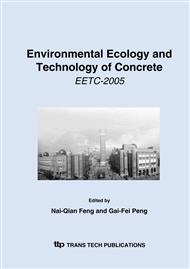[1]
G. Ye: Experimental Study & Numerical Simulation of the Development of the Micro- structure and Permeability of Cementitious Materials ( Delft University of Technology, Delft, 2003).
Google Scholar
[2]
E.J. Garboczi, and D.P. Bentz: Constr. Building Mater. 10(1996), p.293.
Google Scholar
[3]
P. Navi, and C. Pignat: Advn. Cem. Based. Mater. 4(1996), p.58.
Google Scholar
[4]
E.J. Garboczi and D.P. Bentz: Cem. Concr. Res. 31(2001), p.1501.
Google Scholar
[5]
G. Ye: Percolation of capillary pore in hardening cement pastes, Cem. Concr. Res. (2005), (in press).
Google Scholar
[6]
E. G. Nawy: Fundamentals of High Performance Concrete. 2nd Edn. (John Wiley & Sons, New York, 2001).
Google Scholar
[7]
S. Diamond, S. Mindess, and J. Lovell: On the Spacing between Aggregate Grains in Concrete and the Dimension of the Aureole de Transition. Proceedings of Liaisons Pastes de Ciment/ Materiaux Associates, Toulouse, France, 1982, pp. C42-C46.
Google Scholar
[8]
H.S. Chen, P. Stroeven and M. Stroeven, et al.: Nearest Surface Spacing between Neighboring Aggregate Particles in Concrete: Theoretical Solution, Proceedings of the International Conference on Advances in Concrete Composites and Structures, Chennai, India, January 6~8, 2005 (in press).
Google Scholar
[9]
H.S. Chen, G. Ye and P. Stroeven: Computer Simulation of Structure of Hydrated Cement Paste Enclosed by Interfacial Transition Zone in Concrete, Proceedings of the International Conference on Durability of High Performance Concrete and Final Workshop of CONLIFE, Essen, Germany, 2004, pp.133-144.
Google Scholar
[10]
H.S. Chen, P. Stroeven, and G. Ye: Influence of Aggregate Surface Spacing on the Microstructure of Interfacial Transition Zone in Fresh and Hardened Model Cement Paste, Proceedings of the 3rd International Conference on Construction Materials: Performance, Innovations and Structural Implications (ConMat'05) , Vancouver, Canada, August 22-24, 2005 (in press).
Google Scholar
[11]
M. Stroeven, Discrete Numerical Modelling of Composite Materials (Delft University of Technology, Delft, 1999).
Google Scholar
[12]
P. Stroeven: Some Aspects of the Micromechanics of Concrete (Delft University of Technology, Delft, 1973).
Google Scholar
[13]
C.B. Brown: J. Franklin Inst. 279 (1965), p.189.
Google Scholar
[14]
Z. Hashin: J. Appl. Mech. 50(1983), p.481.
Google Scholar
[15]
K. van Breugel: Simulation of Hydration and Formation of Structure in Hardening Cement- Based Materials. Delft University of Technology, Delft, 1997).
Google Scholar
[16]
D.P. Bentz, D.A. Quenard, and H.M. Kunzel, et al.: Mater. & Struct. 33 (2000), p.147.
Google Scholar
[17]
K.L. Scrivener, E. Gallucci and T. Füllmann, et al.: The Challenge of Quantification of Cementitious Systems, Proceedings of Advances in Concrete through Science and Engineering, Proceedings of the International RILEM Symposium(CD-ROM), Evanston, Illinois, 2004, Paper. 9.
DOI: 10.1617/2912143586.018
Google Scholar
[18]
P. Stroeven and M. Stroeven: Cem. Concr. Compos. 23(2001), p.189.
Google Scholar
[19]
W.T. Elam, A.R. Kerstein, and J.J. Rehr: Phys. Rev. Lett. 52(1984), p.1516.
Google Scholar


